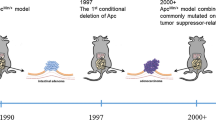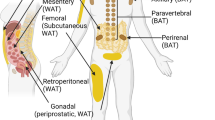Abstract
Recently, it was demonstrated that dietary Ω-3 polyunsaturated fatty acids (PUFAs) induce 10-fold more metastases in number and 1000-fold in volume in an animal model of colon cancer metastasis in rat liver. It was observed that tumors of rats on a fish oil diet lacked peritumoral stroma unlike tumors in livers of rats on a low fat diet or a diet containing Ω-6 PUFAs. In the present study, only one-third of the tumors in livers of rats on Ω-3 PUFA diet contained peritumoral stroma, whereas peritumoral stroma was present in 87% of the tumors in livers of rats on low fat diet. To explain these findings, we tested the hypothesis that fish oil exerts a direct inhibiting effect on the formation of extracellular matrix in tumor stroma as a consequence of blocking transformation of fat storing cells into myofibroblasts. It was found with immunohistochemical analysis of desmin as marker for fat storing cells and α-smooth muscle actin as marker for myofibroblasts that numbers of myofibroblasts were higher in tumors containing intratumoral stroma only than in tumors containing both peritumoral and intratumoral stroma. As most of the tumors in fish oil-treated rats contained intratumoral stroma only, this suggests that transformation of fat storing cells into myofibroblasts was highest in tumor stroma of fish oil-treated rats. Therefore, it is unlikely that the lack of stroma around tumors in fish oil-treated rats is due to inhibition of transformation of fat storing cells into myofibroblasts, but lack of peritumoral stroma is rather a consequence of rapid development of tumors in livers of fish oil-treated rats.
Similar content being viewed by others
References
Sakaguchi M, Rowley S, Kane N et al. Reduced tumour growth of the human colonic cancer cell lines COLO-320 and HT-29 in vivo by dietary n-3 lipids. Br J Cancer 1990; 2: 742–7.
Griffini P, Fehres O, Klieverik L et al. Dietary Ω-3 polyunsaturated fatty acids promote colon carcinoma metastasis in rat liver. Cancer Res 1998; 58: 3312–9.
Dvorak HF. Tumors: Wounds that do not heal. Similarities between tumor stroma generation and wound healing. N Engl J Med 1986; 315: 1650–9.
Dvorak HF. Tumor stroma. In Colvin RB, Bhan AK, McCluskey RT (eds): Diagnostic Immunopathology. New York: Raven Press 1988; 401–20.
Van den Hooff A. Connective tissue changes in cancer. Int Rev Conn Tiss Res 1983; 10: 395–432.
Van den Hooff A. Connective tissue as an active participant in the process of malignant growth. Anticancer Res 1986; 6: 775–80.
Dingemans KP, Van den Bergh-Weerman MA, Keep RF et al. Developmental stages in experimental liver metastasis: Relation to invasiveness. Int J Cancer 1994; 57: 433–9.
Griffini P, Smorenburg SM, Verbeek FJ et al. Three-dimensional reconstruction of colon carcinoma metastases in liver. J Microsc 1997; 187: 12–21.
Terada T, Makimoto K, Terayama N et al. Alpha-smooth muscle actin-positive stromal cells in cholangiocarcinomas, hepatocellular carcinomas and metastatic liver carcinomas. J Hepatol 1996; 24: 706–12.
Ooi LPJ, Crawford DHG, Gotley DC et al. Evidence that 'myofibroblast-like' cells are the cellular source of capsular collagen in hepatocellular carcinoma. J Hepatol 1997; 26: 798–807.
Geerts A, De Bleser P, Hautekeete ML et al. Fat storing (Ito) cell biology. In Arias IM, Boyer JL, Fausto N et al. (eds): The Liver: Biology and Pathobiology. 3rd edition. New York: Raven Press 1994; 819–37.
Pinzani M. Novel insights into the biology and physiology of the Ito cell. Pharmacol Therap 1995; 66: 387–412.
Ogawa K, Suzuki JI, Mukai H et al. Proliferation of Ito cells with enhanced expression of desmin and actin in focal hepatic injury. Am J Pathol 1986; 125: 611–9.
Kojima A, Ueda M, Maki A. Fibrous capsular formation in human hepatocellular carcinoma involves induction of smooth muscle cells. In Knook DL, Wisse E (eds): Cells of Hepatic Sinusoid, Vol 6. Leiden, The Netherlands: Kupffer Cell Foundation 1997; 422–6.
Gressner AM. Transdifferentiation of hepatic stellate cells (Ito cells) to myofibroblasts: a key event in hepatic fibrogenesis. Kidney Internat 1996; 49, Suppl 54: S39–S45.
Olaso E, Santiseban A, Bidaurrazaga J et al. Tumor-dependent activation of rodent hepatic stellate cells during experimental melanoma metastasis. Hepatology 1997; 26: 634–42.
Gulubova MV. Ito cell morphology, α-smooth muscle actin and collagen type IV expression in the liver of patients with gastric and colorectal tumors. Histochem J 2000; 32: 151–64.
Ballardini G, Fallani M, Biagnini G et al. Desmin and actin in the identification of Ito cells and in monitoring their evolution to myofibroblasts in experimental liver fibrosis. Virchows Arch B Cell Pathol 1988; 56: 45–9.
Kaminski WE, Jendraschak E, Kieft R et al. Dietary Ω-3 fatty acids lower levels of platelet-derived growth factor mRNA in human mononuclear cells. Blood 1993; 81: 1871–9.
Van Noorden CJF. Effects of n-3 and n-6 polyunsaturated fatty acid-enriched diets on lipid metabolism in periportal and pericentral compartments of female rat liver lobules and the consequences for cell proliferation after partial hepatectomy. J Lipid Res 1995; 36: 1708–20.
Marquet RL, Westbroek DL, Jeekel J. Interferon treatment of transplantable rat colon adenocarcinoma: Importance of tumor site. Int J Cancer 1984; 33: 689–92.
Martin M, Chauffert B, Caignard A et al. Histoimmunological characterization of the cellular reaction to liver metastases induced by colon cancer cells in syngeneic rats. Invasion Metast 1989; 9: 216–30.
Griffini P, Smorenburg SM, Vogels IMC et al. Kupffer cells and pit cells are not effective in the defense against experimentally induced colon carcinoma metastasis in rat liver. Clin Exp Metastasis 1996; 14: 367–80.
Van Noorden CJF, Jonges GN, Van Marle J et al. Heterogeneous suppression of experimentally induced colon cancer metastasis in rat liver lobes by inhibition of extracellular cathepsin B. Clin Exp Metastasis 1998; 16: 159–67.
Polak JM, Van Noorden S. An Introduction to Immunocytochemistry, 2nd edition. Oxford: Bios 1997.
Caldero J, Campo E, Vinas J et al. Lectin-binding sites in neoplastic and non-neoplastic colonic mucosa of 1,2'-dimethylhydrazine-treated rats. Lab Invest 1989; 61: 670–6.
Dijkhuis FWJ, Jonker AM, Koudstaal J et al. Involvement of perisinusoidal fat-storing cells in the development of granulomatous structures in the rat liver. In Wisse E, Knook DL, Decker K (eds): Cells of Hepatic Sinusoid, Vol 2. Rijswijk, The Netherlands: Kupffer Cell Foundation 1989; 76–9.
Mathew J, Burt AD. Cellular mechanisms of fibrogenesis in genetic haemochromatosis. In Knook DL, Wisse E (eds): Cells of Hepatic Sinusoid, Vol 4. Leiden, The Netherlands: Kupffer Cell Foundation 1993; 274–6.
James J, Bosch KS, Aronson DC et al. Sirius Red histophotometry and spectrophotometry of sections in the assessment of the collagen content of liver tissue and its application in growing rat liver. Liver 1990; 10: 1–5.
Hautekee ML, Geerts A. The hepatic stellate (Ito) cell: Its role in human liver disease. Virchows Arch 1997; 430: 195–207.
Bhunchet E, Wake K. Fibroblasts and myofibroblasts of the rat liver contain desmin. In Knook DL, Wisse E (eds): Cells of the Hepatic Sinusoids. Vol IV. Leiden, The Netherlands: Kupffer Cell Foundation 1993; 256–8.
Tisdale J, Beck SA. Inhibition of tumor-induced lipolysis in vitro and cachexia and tumour growth in vivo by eicosapentaenoic acid. Biochem Pharmacol 1991; 41: 103–7.
Martin D, Meckling-Gill KA. Omega-3 polyunsaturated fatty acids increase purine but not pyrimidine transport in L1210 leukaemia cells. Biochem J 1996; 315: 329–33.
Author information
Authors and Affiliations
Rights and permissions
About this article
Cite this article
Klieverik, L., Fehres, O., Griffini, P. et al. Promotion of colon cancer metastases in rat liver by fish oil diet is not due to reduced stroma formation. Clin Exp Metastasis 18, 371–377 (2000). https://doi.org/10.1023/A:1010813916024
Issue Date:
DOI: https://doi.org/10.1023/A:1010813916024




